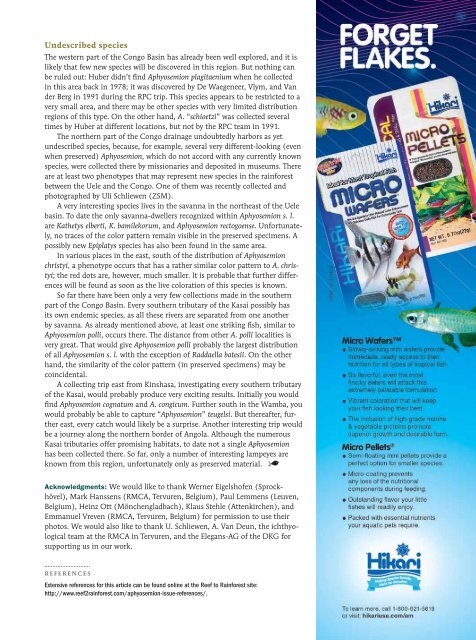Congo Killies - PageSuite
Congo Killies - PageSuite
Congo Killies - PageSuite
You also want an ePaper? Increase the reach of your titles
YUMPU automatically turns print PDFs into web optimized ePapers that Google loves.
Undescribed species<br />
The western part of the <strong>Congo</strong> Basin has already been well explored, and it is<br />
likely that few new species will be discovered in this region. But nothing can<br />
be ruled out: Huber didn’t find Aphyosemion plagitaenium when he collected<br />
in this area back in 1978; it was discovered by De Waegeneer, Vlym, and Van<br />
der Berg in 1991 during the RPC trip. This species appears to be restricted to a<br />
very small area, and there may be other species with very limited distribution<br />
regions of this type. On the other hand, A. “schioetzi” was collected several<br />
times by Huber at different locations, but not by the RPC team in 1991.<br />
The northern part of the <strong>Congo</strong> drainage undoubtedly harbors as yet<br />
undescribed species, because, for example, several very different-looking (even<br />
when preserved) Aphyosemion, which do not accord with any currently known<br />
species, were collected there by missionaries and deposited in museums. There<br />
are at least two phenotypes that may represent new species in the rainforest<br />
between the Uele and the <strong>Congo</strong>. One of them was recently collected and<br />
photographed by Uli Schliewen (ZSM).<br />
A very interesting species lives in the savanna in the northeast of the Uele<br />
basin. To date the only savanna-dwellers recognized within Aphyosemion s. l.<br />
are Kathetys elberti, K. bamilekorum, and Aphyosemion rectogoense. Unfortunately,<br />
no traces of the color pattern remain visible in the preserved specimens. A<br />
possibly new Epiplatys species has also been found in the same area.<br />
In various places in the east, south of the distribution of Aphyosemion<br />
christyi, a phenotype occurs that has a rather similar color pattern to A. christyi;<br />
the red dots are, however, much smaller. It is probable that further differences<br />
will be found as soon as the live coloration of this species is known.<br />
So far there have been only a very few collections made in the southern<br />
part of the <strong>Congo</strong> Basin. Every southern tributary of the Kasai possibly has<br />
its own endemic species, as all these rivers are separated from one another<br />
by savanna. As already mentioned above, at least one striking fish, similar to<br />
Aphyosemion polli, occurs there. The distance from other A. polli localities is<br />
very great. That would give Aphyosemion polli probably the largest distribution<br />
of all Aphyosemion s. l. with the exception of Raddaella batesii. On the other<br />
hand, the similarity of the color pattern (in preserved specimens) may be<br />
coincidental.<br />
A collecting trip east from Kinshasa, investigating every southern tributary<br />
of the Kasai, would probably produce very exciting results. Initially you would<br />
find Aphyosemion cognatum and A. congicum. Further south in the Wamba, you<br />
would probably be able to capture “Aphyosemion” teugelsi. But thereafter, further<br />
east, every catch would likely be a surprise. Another interesting trip would<br />
be a journey along the northern border of Angola. Although the numerous<br />
Kasai tributaries offer promising habitats, to date not a single Aphyosemion<br />
has been collected there. So far, only a number of interesting lampeyes are<br />
known from this region, unfortunately only as preserved material.<br />
Acknowledgments: We would like to thank Werner Eigelshofen (Sprockhövel),<br />
Mark Hanssens (RMCA, Tervuren, Belgium), Paul Lemmens (Leuven,<br />
Belgium), Heinz Ott (Mönchengladbach), Klaus Stehle (Attenkirchen), and<br />
Emmanuel Vreven (RMCA, Tervuren, Belgium) for permission to use their<br />
photos. We would also like to thank U. Schliewen, A. Van Deun, the ichthyological<br />
team at the RMCA in Tervuren, and the Elegans-AG of the DKG for<br />
supporting us in our work.<br />
REFERENCES<br />
Extensive references for this article can be found online at the Reef to Rainforest site:<br />
http://www.reef2rainforest.com/aphyosemion-issue-references/.<br />
AMAZONAS<br />
33

















